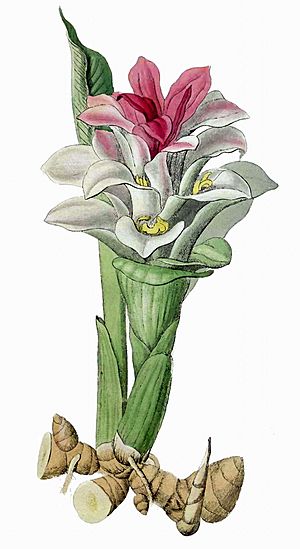The Paradisus Londinensis facts for kids

Part of 96, Curcuma aromatica
|
|
| Author | Richard Anthony Salisbury, William Hooker |
|---|---|
|
Publication date
|
1805 |
The Paradisus Londonensis is a special book about plants. Its full name is The Paradisus Londonensis : or Coloured Figures of Plants Cultivated in the Vicinity of the Metropolis. It was printed between 1805 and 1808.
The book has 117 beautiful colored pictures of plants. These drawings were made by William Hooker. The words explaining the plants were written by Richard Anthony Salisbury.
Contents
When Was the Book Published?
The Paradisus Londonensis was made in two main parts, or volumes. Each volume had two sections. One section held the plant pictures, and the other had the text.
The first part of the book came out in 1805. The last parts were published in 1808. So, the book was released over several years.
- Volume 1, Part 1: June 1805 to May 1806
- Volume 1, Part 2: June 1806 to September 1808
- Volume 2, Part 1: June 1807 to May 1808
- Volume 2, Part 2: June 1808 to September 1808
Why This Book Is Important for Plants
New Plant Names from the Book
The Paradisus Londonensis is a very important book for naming plants. Many plant names we use today came from this book. About 150 plant names were first described by Salisbury in this work.
Some of these names are still used today. Others have been changed over time. The book introduced new names for:
- Two plant families: Dilleniaceae and Droseraceae.
- 36 plant genera (groups of similar plants), like Acis and Calypso.
- 108 plant species (specific types of plants), such as Byblis liniflora and Curcuma aromatica.
A Disagreement About Plant Classification
The book also shows a disagreement between Salisbury and another famous botanist, James Edward Smith. They had different ideas about how to group and name plants.
Smith believed in the "sexual system" of classification, created by Carl Linnaeus. He even bought Linnaeus's whole plant collection. Smith also started the Linnean Society.
Salisbury, however, preferred the "natural system" of classification. This system was developed by Antoine Laurent de Jussieu. The Paradisus Londonensis uses this natural system.
How the Disagreement Affected Plant Names
In 1807, Smith wrote about new plants from British Columbia, Canada. He thought their flowers had six inner petals. Salisbury disagreed. In The Paradisus Londonensis, he named these plants Hookera. He explained that the "petals" Smith saw were actually parts of the stamens (male parts of the flower).
Soon after, Smith named a moss genus Hookeria. He also named the same plant Salisbury called Hookera as Brodiaea. Some people believe Smith did this to prevent Salisbury from getting credit for the name Hookera.
Because Smith's names became very popular, they were officially "conserved." This means they were kept, even though Salisbury's names came first. However, Salisbury's specific plant name coronaria is still used in Brodiaea coronaria.
What's Inside the Book
The Paradisus Londonensis features 117 different plants with illustrations. The book lists each plant with its scientific name. Many of these names are still used, or they are now known as synonyms for other accepted names.
See also
 In Spanish: Paradisus Londinensis para niños
In Spanish: Paradisus Londinensis para niños

